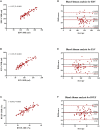Right Ventricular Function Predicts Adverse Clinical Outcomes in Patients With Chronic Thromboembolic Pulmonary Hypertension: A Three-Dimensional Echocardiographic Study
- PMID: 34497813
- PMCID: PMC8419302
- DOI: 10.3389/fmed.2021.697396
Right Ventricular Function Predicts Adverse Clinical Outcomes in Patients With Chronic Thromboembolic Pulmonary Hypertension: A Three-Dimensional Echocardiographic Study
Abstract
Background: Right ventricular (RV) function plays a vital role in the prognosis of patients with chronic thromboembolic pulmonary hypertension (CTEPH). We used new machine learning (ML)-based fully automated software to quantify RV function using three-dimensional echocardiography (3DE) to predict adverse clinical outcomes in CTEPH patients. Methods: A total of 151 consecutive CTEPH patients were registered in this prospective study between April 2015 and July 2019. New ML-based methods were used for data management, and quantitative analysis of RV volume and ejection fraction (RVEF) was performed offline. RV structural and functional parameters were recorded using 3DE. CTEPH was diagnosed using right heart catheterization, and 62 patients underwent cardiac magnetic resonance to assess right heart function. Adverse clinical outcomes were defined as PH-related hospitalization with hemoptysis or increased RV failure, including conditions requiring balloon pulmonary angioplasty or pulmonary endarterectomy, as well as death. Results: The median follow-up time was 19.7 months (interquartile range, 0.5-54 months). Among the 151 CTEPH patients, 72 experienced adverse clinical outcomes. Multivariate Cox proportional-hazard analysis showed that ML-based 3DE analysis of RVEF was a predictor of adverse clinical outcomes (hazard ratio, 1.576; 95% confidence interval (CI), 1.046~2.372; P = 0.030). Conclusions: The new ML-based 3DE algorithm is a promising technique for rapid 3D quantification of RV function in CTEPH patients.
Keywords: clinical failure; machine learning; prognosis; pulmonary hypertension; right ventricular function; three-dimensional echocardiography.
Copyright © 2021 Li, Liang, Guo, Yang, Gong, Zhang, Zhang, Jiang and Lu.
Conflict of interest statement
The authors declare that the research was conducted in the absence of any commercial or financial relationships that could be construed as a potential conflict of interest.
Figures






Similar articles
-
Prognostic Value of the Right Ventricular Ejection Fraction, Assessed by Fully Automated Three-Dimensional Echocardiography: A Direct Comparison of Analyses Using Right Ventricular-Focused Views versus Apical Four-Chamber Views.J Am Soc Echocardiogr. 2021 Feb;34(2):117-126. doi: 10.1016/j.echo.2020.09.016. Epub 2020 Nov 2. J Am Soc Echocardiogr. 2021. PMID: 33153858
-
Balloon pulmonary angioplasty reverse right ventricular remodelling and dysfunction in patients with inoperable chronic thromboembolic pulmonary hypertension: a systematic review and meta-analysis.Eur Radiol. 2021 Jun;31(6):3898-3908. doi: 10.1007/s00330-020-07481-6. Epub 2020 Nov 17. Eur Radiol. 2021. PMID: 33201287
-
Long-term changes of right ventricular myocardial deformation and remodeling studied by cardiac magnetic resonance imaging in patients with chronic thromboembolic pulmonary hypertension following pulmonary thromboendarterectomy.Int J Cardiol. 2020 Feb 1;300:282-288. doi: 10.1016/j.ijcard.2019.09.038. Epub 2019 Oct 30. Int J Cardiol. 2020. PMID: 31744721
-
Characteristics of Right Ventricular Blood Flow in Patients With Chronic Thromboembolic Pulmonary Hypertension: An Analysis With 4-Dimensional Flow Cardiovascular Magnetic Resonance Imaging.Front Cardiovasc Med. 2022 Jun 15;9:900301. doi: 10.3389/fcvm.2022.900301. eCollection 2022. Front Cardiovasc Med. 2022. PMID: 35783864 Free PMC article.
-
European Association of Cardiovascular Imaging/Cardiovascular Imaging Department of the Brazilian Society of Cardiology recommendations for the use of cardiac imaging to assess and follow patients after heart transplantation.Eur Heart J Cardiovasc Imaging. 2015 Sep;16(9):919-48. doi: 10.1093/ehjci/jev139. Epub 2015 Jul 2. Eur Heart J Cardiovasc Imaging. 2015. PMID: 26139361 Review.
Cited by
-
Role and application of three-dimensional transthoracic echocardiography in the assessment of left and right ventricular volumes and ejection fraction: a UK nationwide survey.Echo Res Pract. 2024 Apr 3;11(1):8. doi: 10.1186/s44156-024-00044-1. Echo Res Pract. 2024. PMID: 38566154 Free PMC article.
-
Added value of 3D echocardiography in the diagnosis and prognostication of patients with right ventricular dysfunction.Front Cardiovasc Med. 2023 Dec 21;10:1263864. doi: 10.3389/fcvm.2023.1263864. eCollection 2023. Front Cardiovasc Med. 2023. PMID: 38179507 Free PMC article. Review.
-
A Comprehensive Review of Artificial Intelligence (AI) Applications in Pulmonary Hypertension (PH).Medicina (Kaunas). 2025 Jan 7;61(1):85. doi: 10.3390/medicina61010085. Medicina (Kaunas). 2025. PMID: 39859065 Free PMC article.
-
Nonsurgical treatment of a patient with decompensated right ventricular failure due to chronic thromboembolic pulmonary hypertension with proximal clot location-A case report.Pulm Circ. 2024 Jun 23;14(2):e12400. doi: 10.1002/pul2.12400. eCollection 2024 Apr. Pulm Circ. 2024. PMID: 38911185 Free PMC article.
-
Clinical value of artificial intelligence 3D echocardiography in evaluating left atrial volume and pulmonary vein structure in patients with atrial fibrillation.Clinics (Sao Paulo). 2024 Sep 15;79:100487. doi: 10.1016/j.clinsp.2024.100487. eCollection 2024. Clinics (Sao Paulo). 2024. PMID: 39284276 Free PMC article.
References
-
- Ende-Verhaar YM, Cannegieter SC, Vonk Noordegraaf A, Delcroix M, Pruszczyk P, Mairuhu AT, et al. . Incidence of chronic thromboembolic pulmonary hypertension after acute pulmonary embolism: a contemporary view of the published literature. Eur Respir J. (2017) 49:1601792. 10.1183/13993003.01792-2016 - DOI - PubMed
LinkOut - more resources
Full Text Sources
Miscellaneous

